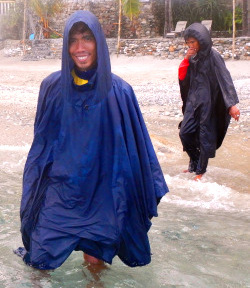Rain and Showers
Knowing the difference between rain and showers can make your day. Forecasts distinguish between two different symbols referencing showers or rain.
Showers

 A cloud with a sun or moon means frequent showers with clear spells.
Ideal wet hiking weather with a chance to dry out.
A cloud with a sun or moon means frequent showers with clear spells.
Ideal wet hiking weather with a chance to dry out.
Rain

 A dark grey cloud means rain
with wet weather for hours or days at a time.
You'll be soaking wet for most of your hiking trip.
A dark grey cloud means rain
with wet weather for hours or days at a time.
You'll be soaking wet for most of your hiking trip.
Always Check Forecast and Weather
The difference between showers and rain becomes readily apparent when you take a top-down look at the weather map. Rain is evident in a large organised band of rainfall moving across the region, while isolated showers spout up and disappear here and there.
Listening to the weather forecast or reading the weather maps is a good habit to establish irrespective of the climate. Keep an eye on the weather near you. Forecasts can sometimes be wrong. Are there fast rising clouds? Does the wind change?
Adapting is a lot easier when you know what’s coming. If conditions are deteriorating, don’t hesitate to set up your shelter, go for a quick dip to rinse the sweat and dirt from your wet clothes, and then call it a day.

Amphibian rain clothes are fun without being too heavy.

Thin layers keep you warmer.
Rain
Rain is the precipitation that falls from a weather front, a boundary between two bodies of air that have different properties. Fronts produce most of their rain through mass ascent. Mass ascent is where one body of air is lifted, bodily upwards, by another body of air. The lifted body of air cools and the water vapour it contains condenses to form clouds and then rain.
Frontal clouds may stretch for hundreds of miles, usually consisting of various types of stratus cloud, including stratus, altostratus and nimbostratus. Such rain systems bring precipitation to a large area which makes it hard to avoid because the rain often stretches along the entire length of the front. This can last for a day or so and they are commonly associated with unsettled weather.
When a weather front brings rain, it will usually bring continuously grey skies,
with rain falling through a large portion of the day.
In these situations, weather forecasters tend to use the terms 'persistent rain' or 'prolonged rainfall'.
The key differences relate to the types of cloud that lead to their formation
and the resulting difference in the duration and intensities of the downpours.
Showers
While showers are technically a type of rain, they usually fall from individual clouds you can see in the sky so the rain will be on and off, with gaps of drier and brighter weather in between. It is quite hit and miss where they occur, and this means that you could get heavy showers on and off through the day, whereas in the next town their weather stays dry all day. Really heavy downpours penetrate even the coated nylon of a rain cape in seconds.
On any day with a shower in the forecast, it is usually best to prepare to get rained on, even if it looks bright outside. On some days there will be frequent showers, on other days you may just catch one brief shower and then it stays dry the rest of the day.
The best way to tell if you will get a shower soon is on the rainfall map. You can see where the showers are, how heavy or frequent they will be, and if they are moving towards you. If you want to know further ahead, the 'next 24 hours' section shows where the showers are forecast to be in future.
The largest cumulus clouds are called cumulonimbus and reach high enough into the atmosphere to contain ice, rather than water droplets. Whilst cumulonimbus clouds are large relative to an observer on the ground, they are not on the same scale as the body of cloud associated with a front.
A mature cumulonimbus cloud can be tens of thousands of feet high and many miles in diameter,
but unlike frontal cloud, they are relatively narrow.
A cumulonimbus cloud will last for tens of minutes to hours,
and so showers tend to be sudden and brief whereas frontal rain can last for days.
What causes a Shower?
Showers are produced by convective clouds known as cumulus. Rain-bearing cumulus clouds are commonly taller than they are wide and have a fluffy, cauliflower-like appearance to their tops.
A cumulus or cumulonimbus cloud will begin life as a 'bubble' of buoyant air that rises upwards in the atmosphere. The bubble of air will cool as it gains height and this will lead to the formation of the cumulus cloud with its distinctive cauliflower-like top. The head of the cloud shows where buoyant air is continuing to ascend into the air of the surrounding atmosphere.
Once the cumulus cloud reaches a certain height or attains a cold enough cloud top temperature, it will produce rain.
Rain often falls in a downdraught within the cumulus cloud and suppresses the updraught that originally formed the cumulus cloud,
which limits the life-span of a cumulus cloud.
Swimming in the Rain
Rain swimming is a wonderful experience, much more fun than swimming on a sunny day, so long as you do so safely.
When you swim outdoors many times, you’re bound to run into a sudden downpour. It feels almost calming for some reason. Some swimmers definitely prefer it.
An advantage of swimming in the rain is that the water feels suddenly warmer. It also is incredibly relaxing due to the white noise it makes.
A swimmer sees rain from a unique perspective, as raindrops form balls that race across the water surface, or bounce back, creating small fountains of water where they rebound.
Wind can also add to the outdoor experience,
creating a wild landscape in the most domestic of swim spots.
Beware of getting too cold from wind chill.
Always wear a windbreaker like an anorak or such.

Comfy quick drying swimsuit.

Dries faster than shirt and shorts.

Ponchos add warmth.
Hypothermia from Rain Drops
Something not many people consider is that cool rain droplets can cause hypothermia during heavy rains.
Since precipitation lingers at high altitudes where the air temperature maybe near freezing, the rain droplets are also cold. When these rain droplets begin their descent towards the ground, they don't have nearly enough time to heat up, which is why rain feels cool to the touch.
You may be bombarded with lots of cool rain droplets during heavy rains. Prolonged exposure gradually depletes internal heat from your body, giving rise to hypothermic symptoms.
Swimmers may not detect the onset of hypothermia. Many confuse these hypothermic symptoms with the sudden shock of cold that runs through the body when immersing themselves in chilled water. This confusion allows the hypothermia to go unnoticed until their condition reaches a point where they can no longer ignore it.
The solution is to wear clothing layers that keep the rain drops off your skin and retain your body's warmth.
Anoraks, ponchos or rain capes over a fleece layer let you enjoy a rainy swim.
Outdoor Pools
Rainy days are the best time to visit outdoor pools. Only a few hardy people will go, so the pool will be nice and empty. Add a "Samoan Style" to your swim in the rain, go into the water fully clothed.
Slippery when Wet
It is a good idea to be careful around your pool when it's raining
because your deck and other surface areas can be more slippery than usual.
If you slide and fall around the pool, you can seriously injure yourself on a hard concrete or wooden deck,
but you can also fall into the water unconscious.
A jogging suit worn with the hood up may soften a fall.
Reader Story: Rain Swimming in Ireland
by Patrick from CorkIt rains a lot in our region and I often get soaking wet on my hikes along the coast or inland. My windbreakers and ponchos are no longer waterproof because I swim in them all the time. When the rain clouds come I know I'll get soaked to skin, which I enjoy a lot.
Once I get wet in a rain shower I might as well go for a swim in the sea or the nearby lakes. My friends often join me and we all go swimming fully clothed with leaky rain clothes on top. Soon the sun comes out again to dry us.

My friend loves in the water.

He always swim in clothes.